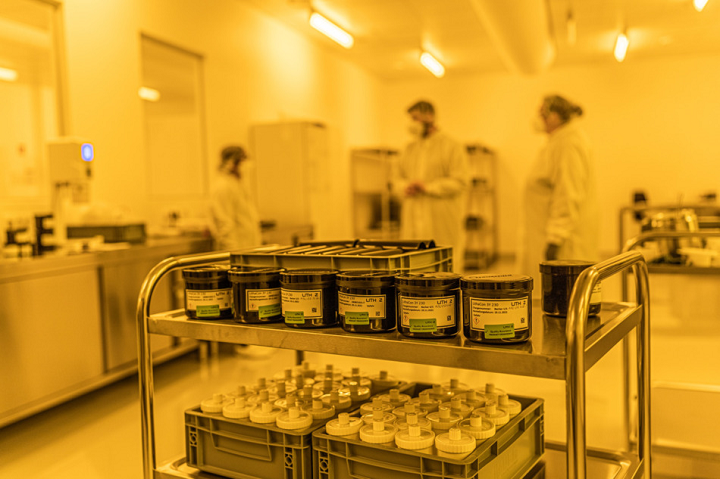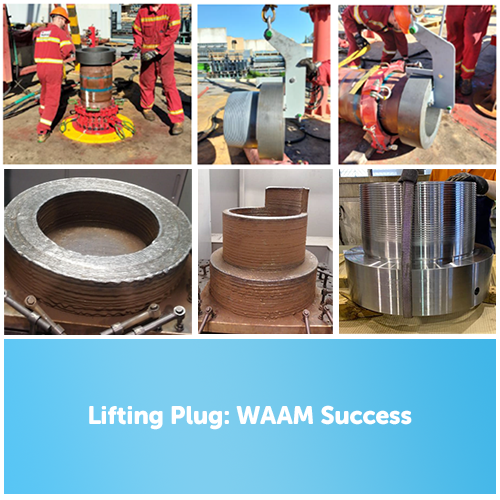We’re starting with a little research in today’s 3D Printing News Briefs, about how embedded mica platelets can improve PEKK properties, and then moving on to business, with a new executive at Markforged and the first package dispatch from the new Lithoz site. Vallourec 3D printed two safety-critical parts for an oil and gas company. Finally, an emerging footwear brand is using 3D printing for its unique shoe designs. Read on for the details!
Mica-Embedded PEKK Extrusion 3D Printing
A class of semi-crystalline thermoplastics called polyaryletherketones (PAEKs) feature chemical resistance, strength, high temperature tolerance, and high glass transition temperatures, and can be used as a metal replacement in multiple industries. Materials in this class, like polyetheretherketone (PEEK) and polyetherketoneketone (PEKK), are often used as AM feedstocks, and PEKK in particular features rigid ketone groups that lower its melting temperature and increase its glass transition temperature, which can reduce warping and make it easier to process in extrusion-based 3D printers. However, PEKK is not without its challenges, and researchers from the Pacific Northwest National Laboratory (PNNL) published a study on how to improve the properties of PEKK by embedding it with mica platelets as a filler to improve thermal conductivity and mechanical properties. Sheet-like phyllosilicate materials, micas have high aspect ratios, good electrical and mechanical properties, are safe when embedded into matrixes, and low-cost, and the team predicted that mica fillers would improve the properties of extrusion-based PEKK 3D printing, without adversely effecting the material’s chemical reactivity or stability in extreme environments.
“Here, we report the integration of three grades of mica platelets into PEKK at 10% and 30% mass loadings to generate an array of filament feedstocks that were used to print objects with a simple FFF machine. The effects of mica coating chemistry on the compatibility with PEKK and resulting properties are described,” the researchers wrote.
“The printed composites were effectively cold crystallized post-printing similarly to unfilled PEKK resulting in increased dimensional stabilities. All micas, when used as fillers in low and high relative PEKK crystallinities, increased the tensile modulus of parts in correlation to the loading.”
Markforged Hires Chief Marketing Officer
On to business, as Markforged has completed its executive leadership team with the appointment of Andrew Hally as Chief Marketing Officer (CMO), effective January 4th. Hally has 25 years of experience in technology marketing, most recently as CMO at digital asset management company Bynder, and in this newly created role, he will help drive brand awareness and speed growth of the Digital Forge, as well as oversee the company’s marketing operations from strategy positioning to demand generation. Reporting directly to the company’s CEO and President Shai Terem, Hally will work out of Markforged’s global headquarters in Watertown, endeavoring to align and boost marketing efforts for the company’s growth plans and goals.
“The most interesting years of my early career combined hardware and software technology breakthroughs to accelerate 3D design and prototyping. Today, the advance of 3D printing into end-use parts promises to transform manufacturing across industries, with benefits not only for engineers and firms but also for the environment and society. I’m honored and excited to join the team at Markforged to help realize this important vision,” Hally said.
Lithoz Dispatches First Shipment from New Site

Second production facility combines greatly increased capacity, efficient warehousing and a new level of quality management
Ceramic 3D printing leader Lithoz GmbH, a spin-off of TU Wien, opened its second Vienna, Austria production site this summer, which is the fourth location worldwide after its American and Chinese bases and Vienna headquarters. Now, the company announced that it has entered production at the new XL hub, and that it recently dispatched the first customer shipment from there as well. This new central warehouse has more storage capacity for raw materials and scalable production, both of which help offer a quicker order turnaround for customers, and quality control is top-notch thanks to a monitored production environment and a quality assurance laboratory. All of these features combine to ensure the new site can offer more efficient warehousing and logistics, which will allow for better customer support around the world.
“During the planning and implementation of this new production site, we focused on sustainability, scalability and reliability,” explained project leader Dr. Daniel Bomze. “We are ready and extremely well prepared for meeting the fast growing demand of our customers.”
Vallourec Uses WAAM 3D Printing to Make Lifting Plugs
French multinational manufacturing company Vallourec used Wire Arc Additive Manufacturing ( WAAM) to make two lifting plugs for oil and gas company Weatherford. These plugs, typically made from forged thick-wall bars, are safety-critical components that act as the junction between pipes and the rig elevator, and are used on the surface of the oil rig so operators can safely move and handle long, heavy tubular products. They usually take a long time to make, as they require non-standard material with unique mechanical properties, in addition to customized dimensions so all the components are compatible, because lifting plugs connect with existing equipment. Weatherford needed a VAM® TTR HW Riser Lifting Plug capable of 100T for a customer off the Australian coast, and Vallourec turned to its WAAM robot in Singapore, which was only a six-hour flight from Weatherford’s customer. This technology, which combines direct deposition 3D printing with laser hot wire welding or automated metal inert gas (MIG) welding, was faster, more affordable, and could handle the necessary non-standard diameters, and the outside diameter (OD) of the lifting plugs—delivered in under two months rather three or four—increased by 15%.
“Thanks to WAAM, we were able to manufacture a lifting plug in half the time of the traditional process with the same mechanical properties and meeting the customer’s specific OD requirements with no minimum order quantity,” said Jinwei Li, Asia Pacific Sales Manager at Vallourec. “This wouldn’t have been possible with traditional processes as we would have been limited to the OD of the available solid bar or we would have had to purchase a new solid bar with a larger OD further extending the lead time.”
3D Printed Avant-Garde SCRY Lab Shuttle Shoes
Finally, an emerging footwear brand and laboratory based in Beijing, called SCRY Lab, is headed by 22-year-old Zixiong Wei, who enjoys using 3D printing because it allows for more experimentation in making shoes, even if a prototype doesn’t work. Wei spoke with HYPEBEAST about his Digital Embryo philosophy, the conceptual design for its signature SCRY Lab Shuttle silhouette, and just a little about 3D printing, though I wish he’d said more. He explained that he first became interested in sneakers in junior high, learning about each brand’s history and design, and how he was first inspired by Nike’s Wind series for the concept behind the SCRY brand. About 70% of the drain grooves in the SCRY Shuttle were designed so it could be 3D printed in full, and Wei said that product development takes about two weeks, though launching a pair of shoes entails a lot of marketing and sales plans, so the cycle for that is about two months.
“Outside a large company, it is a big challenge and investment to make a new pair of shoes. Even so, I was determined to lower the threshold of shoe design and manufacturing, and established the SCRY brand. SCRY has been exploring different future possibilities, rather than pursuing lighter, faster, and more resilient forward directions in the traditional sense. Sometimes, it is not the internal things that disrupt an industry,” Wei said.
“The concept of “Digital Embryo” is a framework technology that aims to run through the entire design and manufacturing process of a pair of shoes with a fully digital process, all while achieving the 3D printing mass production capacity, thus ensuring scalability of virtual shoes. It can also realize a seamless online and offline business model.
“For example, I can produce a lot of virtual simulation concept shoes and let consumers choose and order shoes, and then I will print them. Furthermore, the “Digital Embryo” as the underlying framework can achieve true modular customization. A shoe can have hundreds of combinations.”
Subscribe to Our Email Newsletter
Stay up-to-date on all the latest news from the 3D printing industry and receive information and offers from third party vendors.
Print Services
Upload your 3D Models and get them printed quickly and efficiently.
You May Also Like
Consolidation in AM: How 2025 Is Shaping the Industry’s New Normal
The first half of 2025 has been marked by a clear shift in the additive manufacturing (AM) industry. Companies are no longer just focused on developing new tech by themselves....
Etsy Design Rule Change Reduces Selection of 3D Printed Goods
Online marketplace Etsy has implemented a rule change requiring all 3D printed goods on the site to be original designs. The update to the site’s Creativity Standards states, ¨Items produced using...
U.S. Congress Calls Out 3D Printing in Proposal for Commercial Reserve Manufacturing Network
Last week, the U.S. House of Representatives’ Appropriations Committee moved the FY 2026 defense bill forward to the House floor. Included in the legislation is a $131 million proposal for...
Transforming From Tourist to Native: Duro CEO Michael Corr Explains Why the Company Rebuilt its PLM Software on AI
In these early innings of the AI boom, many market analysts have expressed concern that AI spend has gotten too far ahead of the technology’s proven ability to deliver significant...




































